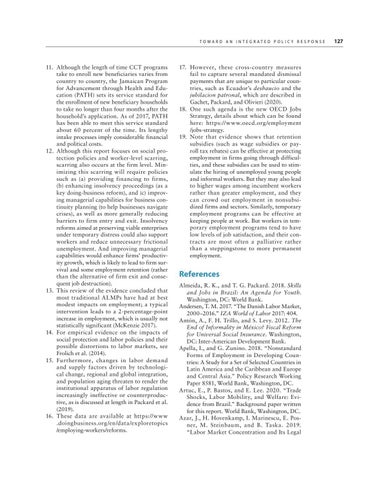T o w a r d a n I n t e g r a t e d P o l i c y R e s p o n s e
11. Although the length of time CCT programs take to enroll new beneficiaries varies from country to country, the Jamaican Program for Advancement through Health and Education (PATH) sets its service standard for the enrollment of new beneficiary households to take no longer than four months after the household’s application. As of 2017, PATH has been able to meet this service standard about 60 percent of the time. Its lengthy intake processes imply considerable financial and political costs. 12. Although this report focuses on social protection policies and worker-level scarring, scarring also occurs at the firm level. Minimizing this scarring will require policies such as (a) providing financing to firms, (b) enhancing insolvency proceedings (as a key doing-business reform), and (c) improving managerial capabilities for business continuity planning (to help businesses navigate crises), as well as more generally reducing barriers to firm entry and exit. Insolvency reforms aimed at preserving viable enterprises under temporary distress could also support workers and reduce unnecessary frictional unemployment. And improving managerial capabilities would enhance firms’ productivity growth, which is likely to lead to firm survival and some employment retention (rather than the alternative of firm exit and consequent job destruction). 13. This review of the evidence concluded that most traditional ALMPs have had at best modest impacts on employment; a typical intervention leads to a 2-percentage-point increase in employment, which is usually not statistically significant (McKenzie 2017). 14. For empirical evidence on the impacts of social protection and labor policies and their possible distortions to labor markets, see Frolich et al. (2014). 15. Furthermore, changes in labor demand and supply factors driven by technological change, regional and global integration, and population aging threaten to render the institutional apparatus of labor regulation increasingly ineffective or counterproductive, as is discussed at length in Packard et al. (2019). 16. These data are available at https://www .doingbusiness.org/en/data/exploretopics /employing-workers/reforms.
17. However, these cross-country measures fail to capture several mandated dismissal payments that are unique to particular countries, such as Ecuador’s deshaucio and the jubilacion patronal, which are described in Gachet, Packard, and Olivieri (2020). 18. One such agenda is the new OECD Jobs Strategy, details about which can be found here: https://www.oecd.org /employment /jobs-strategy. 19. Note that evidence shows that retention subsidies (such as wage subsidies or payroll tax rebates) can be effective at protecting employment in firms going through difficulties, and these subsidies can be used to stimulate the hiring of unemployed young people and informal workers. But they may also lead to higher wages among incumbent workers rather than greater employment, and they can crowd out employment in nonsubsidized firms and sectors. Similarly, temporary employment programs can be effective at keeping people at work. But workers in temporary employment programs tend to have low levels of job satisfaction, and their contracts are most often a palliative rather than a steppingstone to more permanent employment.
References Almeida, R. K., and T. G. Packard. 2018. Skills and Jobs in Brazil: An Agenda for Youth. Washington, DC: World Bank. Andersen, T. M. 2017. “The Danish Labor Market, 2000−2016.” IZA World of Labor 2017: 404. Antón, A., F. H. Trillo, and S. Levy. 2012. The End of Informality in México? Fiscal Reform for Universal Social Insurance. Washington, DC: Inter-American Development Bank. Apella, I., and G. Zunino. 2018. “Nonstandard Forms of Employment in Developing Countries: A Study for a Set of Selected Countries in Latin America and the Caribbean and Europe and Central Asia.” Policy Research Working Paper 8581, World Bank, Washington, DC. Artuc, E., P. Bastos, and E. Lee. 2020. “Trade Shocks, Labor Mobility, and Welfare: Evidence from Brazil.” Background paper written for this report. World Bank, Washington, DC. Azar, J., H. Hovenkamp, I. Marinescu, E. Posner, M. Steinbaum, and B. Taska. 2019. “Labor Market Concentration and Its Legal
127

